Printable COMPASS vaping brochure(PDF)
Changes in the e-cigarette environment
- There have been rapid shifts in the language used to describe e-cigarette use (or vaping) behaviour and in the type of devices used by youth. COMPASS continuously monitors these shifts and revises questionnaire wording to reflect current terminology.
- Shifts in regulation of e-cigarette devices in Canada can impact use among youth. Devices containing nicotine have been legalized, increasing availability and advertising. COMPASS data can evaluate how changes in these regulations impact e-cigarette use behaviours and reasons for use among participating students.
Trends in e-cigarette use among students in the COMPASS Study
Did you know?
- Among Ontario students participating in COMPASS in 2018/19, 28% of males and 23% of females aged 15-19 have used e-cigarettes at least once in the last 30 days.
- Current e-cigarettes use has increased from 8% in 2013/14 to 26% in 2018/19 among COMPASS participants in Ontario.
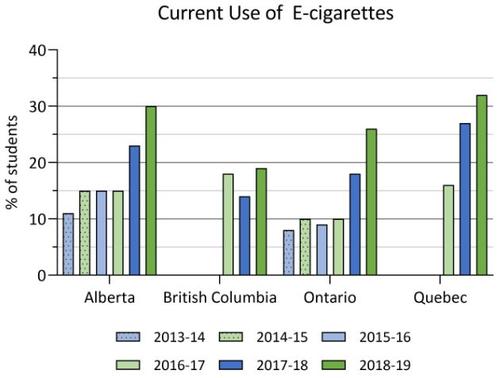
This figure describes the percent of students who currently use e-cigarettes in Alberta, British Columbia, Ontario, and Quebec from 2013/14 to 2018/19; current use has increased in all provinces over this time.
Current e-cigarette use is defined as any use in the past 30 days
Source: 2013-14 to 2018-19 COMPASS schools
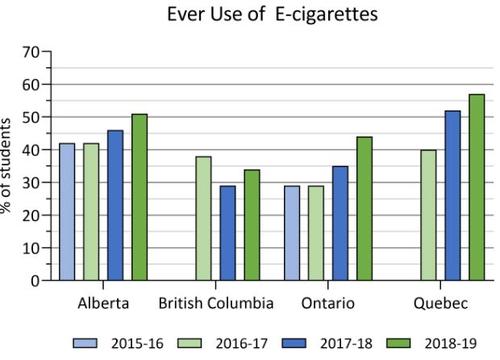
This figure describes the percent of students who have ever used e-cigarettes in Alberta, British Columbia, Ontario and Quebec from 2015/16 to 2018/19; ever use has increased in all provinces except British Columbia.
Ever use is defined as ever having tried e-cigarettes
Source: 2015-16 to 2018-19 COMPASS schools
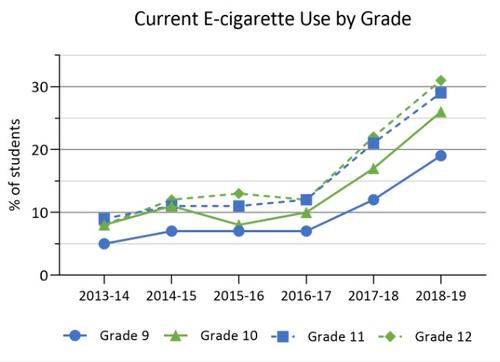
This figure describes the percent of grade 9, 10, 11, and 12 students who currently use e-cigarettes from 2013/14 to 2018/19; current use has increased in all grades over this time.
Source: 2013-14 to 2018-19 COMPASS Ontario schools
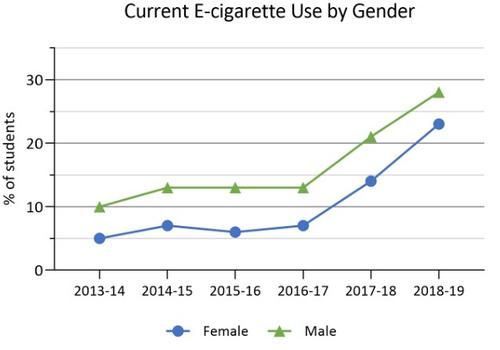
This figure described the percent of male and female students who currently use e-cigarettes from 2013/14 to 2018/19; use has increased amongst males and females over this time.
Source: 2013-14 to 2018-19 COMPASS Ontario schools
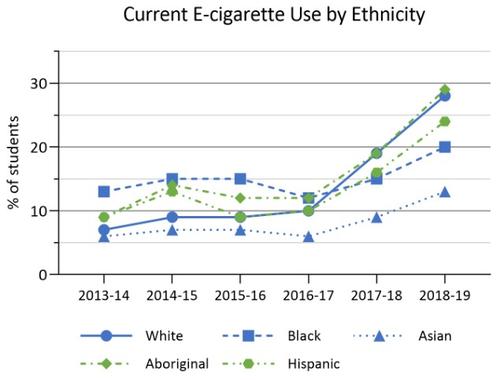
This figure describes the percent of current e-cigarette usage among White, Black, Asian, Aboriginal, and Hispanic students from 2013/14 to 2018/19; current usage has increased across all demographics over this time.
Source: 2013-14 to 2018-19 COMPASS Ontario schools
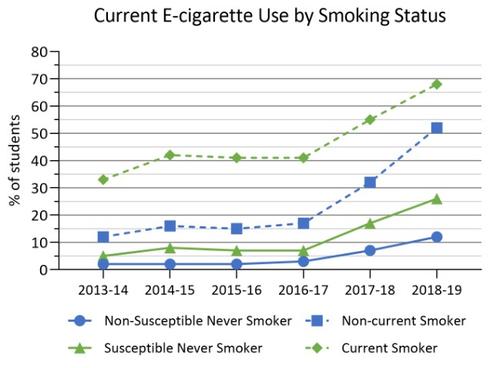
This figure describes the percent of non-susceptible never smokers, susceptible never smokers, non-current smokers, and current smokers using e-cigarettes between 2013/14 and 2018/19; current use increased across all groups over this time.
Source: 2013-14 to 2018-19 COMPASS Ontario schools
Relating youth smoking to e-cigarette use
- COMPASS results suggest that e-cigarettes are expanding the tobacco market by attracting low-risk youth who would otherwise be unlikely to initiate use of cigarettes. (Aleyan et al, 2019)
- Recent COMPASS findings demonstrate a reciprocal relationship between cigarette and e-cigarette use and e-cigarette use was found to predict subsequent cigarette use. (Aleyan et al, 2018)
- E-cigarette use may contribute to the development of a new population of cigarette smokers. (Aleyan et al, 2018)
Other health behaviours associated with e-cigarette use
- COMPASS findings suggest that e-cigarette use is connected with the use of other substances such as cannabis, tobacco and alcohol (alcohol being the strongest link). (Zuckermann et al, 2019)
- Moreover, e-cigarette use has been found to be an important contributing factor in the use of multiple substances (poly-substance use).(Zuckermann et al, 2019)
Reasons for use among e-cigarette users in 2018/19

This figure describes the reasons students use e-cigarettes: curiosity was the most frequent response, followed by other reasons, the ability to use in places smoking is not allowed, to smoke less, and finally to quit.
Values do not add up to 100% as students could select more than one response
Source: 2018-19 COMPASS schools
Built environment and e-cigarettes
- E-cigarette retailer proximity and density surroundinga school were not significantly associated with thelikelihood of ever or currently using e-cigarettes. (Cole et al, 2019)
- These findings suggest that students are accessing e-cigarettes through other sources. (Cole et al, 2019)
- School-level policies banning the use of e-cigarettes on school property may be effective in reducing e-cigarette use (or preventing it) in their current form. (Milicic et al, 2018)